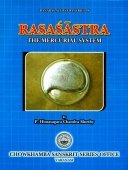Ratnani, Ratnāni: 1 definition
Introduction:
Ratnani means something in Hinduism, Sanskrit. If you want to know the exact meaning, history, etymology or English translation of this term then check out the descriptions on this page. Add your comment or reference to a book if you want to contribute to this summary article.
In Hinduism
Purana and Itihasa (epic history)
Source: Cologne Digital Sanskrit Dictionaries: The Purana Index1a) Ratnāni (रत्नानि).—Of kings; are seven in number; cakra, ratha, maṇi, queen, nidhi, horses and elephants.*
- * Brahmāṇḍa-purāṇa II. 29. 74-5; Matsya-purāṇa 217. 37; Vāyu-purāṇa 57. 68.
1b) The essence got by mountains by milking the cow-earth;1 seven gems in the epoch of Svāyambhuva; generally gems.2

The Purana (पुराण, purāṇas) refers to Sanskrit literature preserving ancient India’s vast cultural history, including historical legends, religious ceremonies, various arts and sciences. The eighteen mahapuranas total over 400,000 shlokas (metrical couplets) and date to at least several centuries BCE.
See also (Relevant definitions)
Starts with: Ratnanicaya, Ratnanidhana, Ratnanidhi.
Ends with: Mahabharatapancaratnani, Shivarahasyapancaratnani, Vikramanavaratnani.
Full-text (+8): Navaratna, Argh, Samudraja, Shran, Kotishas, Amarangana, Svargiya, Gamya, Prithivi, Vararha, Hemakartri, Dadhici, Hemakaraka, Bhasvat, Amarastri, Ciratna, Hemakara, Caturdasha, Dakshinavarta, Jambudvipaka.
Relevant text
Search found 18 books and stories containing Ratnani, Ratnāni; (plurals include: Ratnanis, Ratnānis). You can also click to the full overview containing English textual excerpts. Below are direct links for the most relevant articles:
Lord Jhulelal: An Analytical Study (by Thakkar Harish Gopalji)
Part 5.12 - Shri Uderolal Jo Avtaar Vathnu < [Chapter 2 - Literature Review]
Rig Veda (translation and commentary) (by H. H. Wilson)
Garga Samhita (English) (by Danavir Goswami)
Verse 2.20.9 < [Chapter 20 - The Rāsa-dance Pastime]
Verse 1.12.37 < [Chapter 12 - Description of Śrī Nanda’s Festival]
Verse 1.14.47 < [Chapter 14 - The Liberation of Śakaṭāsura and Tṛṇāvarta]
Sahitya-kaumudi by Baladeva Vidyabhushana (by Gaurapada Dāsa)
Text 10.151 < [Chapter 10 - Ornaments of Meaning]
Text 10.139 < [Chapter 10 - Ornaments of Meaning]
Text 7.101 < [Chapter 7 - Literary Faults]
Manusmriti with the Commentary of Medhatithi (by Ganganatha Jha)
Verse 12.61 < [Section IX - Details of Transmigration]
Verse 2.240 < [Section XXXI - Acquiring of Learning from the Lowest]
Verse 7.218 < [Section XVI - Subsequent Routine]
Puranic encyclopaedia (by Vettam Mani)
Related products
